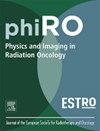开发和全面临床验证的深度神经网络辐射剂量建模,以增强磁共振成像引导放射治疗
IF 3.4
Q2 ONCOLOGY
引用次数: 0
摘要
背景与目的在线自适应磁共振成像(MRI)引导放射治疗需要快速的剂量计算算法,以减少分数内运动的不确定性,提高工作效率。虽然蒙特卡罗模拟很精确,但计算量很大,但神经网络有望在强磁场中快速准确地建立剂量模型。本研究旨在利用综合临床数据集训练和评估用于mri引导放射治疗剂量建模的深度神经网络。材料和方法使用125个1.5 T MRI-Linac放射治疗计划中6595个临床放疗片段的数据集,用于不同肿瘤部位。使用三维成像数据和现场参数作为输入,均方根误差和自定义损失函数,以完整的蒙特卡罗模拟为基础,训练了3961个片段的3D U-Net。对来自50名患者的2656个节段,计算3mm /3%、2mm /2%和1mm /1%标准下的伽马通过率(γ-PR),以评估剂量建模的准确性。还在标准水模中进行了性能测试,以评估基本的辐射物理特性。结果神经网络准确地模拟了患者和水影环境下的剂量分布。治疗方案的γ-PR中位数(范围)分别为97.7%(87.5-100.0%)、89.1%(69.7-99.4%)和60.8%(38.5-82.1%),三个标准中单个区段的γ-PR中位数(范围)分别为97.1%(55.5-100.0%)、88.8%(38.8-99.7%)和61.7%(17.9-94.4%)。结论高中位γ-PR和准确的水影模型和临床数据表明神经网络在剂量模型中具有很高的应用潜力。然而,较低γ-PR的实例强调需要全面的测试数据,改进的鲁棒性和未来内置的不确定性估计。本文章由计算机程序翻译,如有差异,请以英文原文为准。
Development and comprehensive clinical validation of a deep neural network for radiation dose modelling to enhance magnetic resonance imaging guided radiotherapy
Background and purpose
Online adaptive magnetic resonance imaging (MRI)-guided radiotherapy requires fast dose calculation algorithms to reduce intra-fraction motion uncertainties and improve workflow efficiency. While Monte-Carlo simulations are precise but computationally intensive, neural networks promise fast and accurate dose modelling in strong magnetic fields. This study aimed to train and evaluate a deep neural network for dose modelling in MRI-guided radiotherapy using a comprehensive clinical dataset.
Materials and methods
A dataset of 6595 clinical irradiation segments from 125 1.5 T MRI-Linac radiotherapy plans for various tumors sites was used. A 3D U-Net was trained with 3961 segments using 3D imaging data and field parameters as input, Root Mean Squared Error and a custom loss function, with full Monte-Carlo simulations as ground truth. For 2656 segments from 50 patients, gamma pass rates (γ-PR) for 3 mm/3%, 2 mm/2%, and 1 mm/1% criteria were calculated to assess dose modelling accuracy. Performance was also tested in a standardized water phantom to evaluate basic radiation physics properties.
Results
The neural network accurately modeled dose distributions in both patient and water phantom settings. Median (range) γ-PR of 97.7% (87.5–100.0%), 89.1% (69.7–99.4%), and 60.8% (38.5–82.1%) were observed for treatment plans, and 97.1% (55.5–100.0%), 88.8% (38.8–99.7%), and 61.7% (17.9–94.4%) for individual segments, across the three criteria.
Conclusion
High median γ-PR and accurate modelling in both water phantom and clinical data demonstrate the high potential of neural networks for dose modelling. However, instances of lower γ-PR highlight the need for comprehensive test data, improved robustness and future built-in uncertainty estimation.
求助全文
通过发布文献求助,成功后即可免费获取论文全文。
去求助
来源期刊

Physics and Imaging in Radiation Oncology
Physics and Astronomy-Radiation
CiteScore
5.30
自引率
18.90%
发文量
93
审稿时长
6 weeks
 求助内容:
求助内容: 应助结果提醒方式:
应助结果提醒方式:


